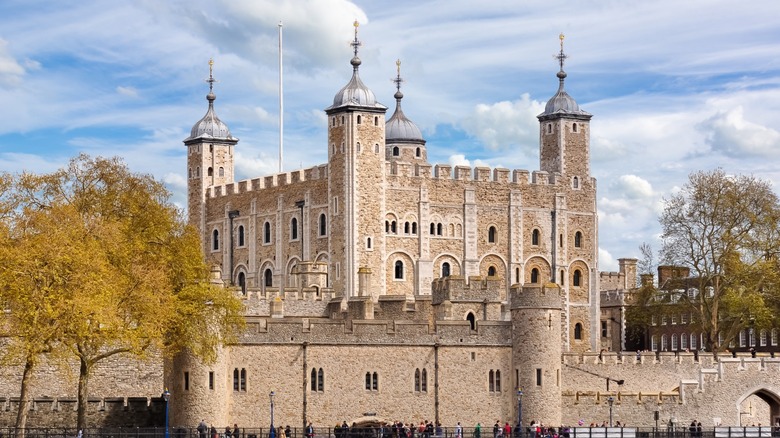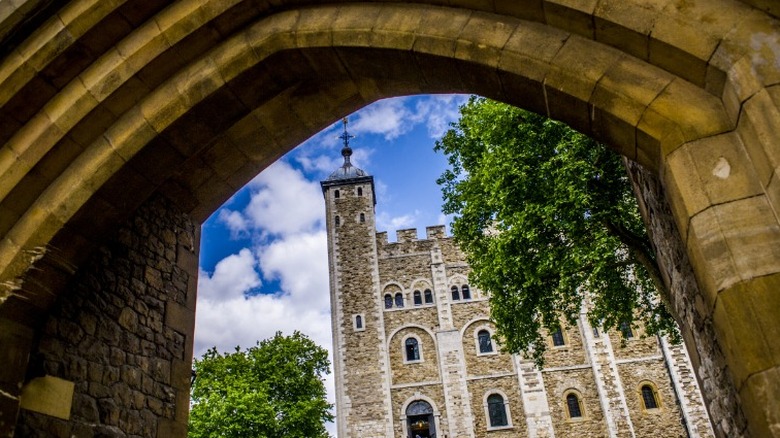The Tower Of London's First Escape Involved A Sly Plot (And A Lot Of Wine)
The Tower of London has served multiple purposes since it was constructed in the latter half of the 11th century. Among its uses have been an armory, a government records depot, and a royal palace. But those who flock to this site for tours are generally interested in hearing about one of its more nefarious uses: a place for political prisoners (via Britannica).
The Tower has been the home to countless hundreds of prisoners, many of them held for being suspected enemies of the Crown. Some of the Tower's occupants would meet their ends there. Nearly two dozen were executed at this royal property along the Thames River, some of whom are reported to still walk the grounds as ghosts. A list of the Tower's previous residents is host to many notable names from history, including Guy Fawkes, Anne Boleyn, and Rudolf Hess (via History).
There have been 40 recorded escapes from the Tower of London, each one a daring and exhilarating story of risking a life for freedom (via Historic Cornwall). Among the more interesting stories of Tower escapes is the one perpetrated by its first prisoner: Bishop Ranulf Flambard. He was thrown into the newly built structure in 1100 by King Henry I (via History Defined). The king wasn't too fond of Flambard, as the man had served in the role of chief minister for Henry's predecessor to the throne (and brother), King William Rufus. The imprisonment of Flambard was thought to make an example out of someone from the corrupt regime that Henry I had taken over. He had Flambard tossed into the Tower on charges of embezzlement, simony, and extortion.
Flambard's life as a prisoner wasn't so bad
When someone mentions 12th-century prison, it might conjure up some pretty awful images of starved people chained to dungeon walls while other poor souls are stretched from the rack. Ranulf Flambard, who had lived quite a lavish lifestyle on the outside, found himself curried favor while locked away. History Defined reports that Henry I allowed the incarcerated Bishop to have his servants on hand in the Tower, as well as other perks that seem out of place for a jail. He dined on the best food that was available and was even known to host some pretty extravagant dinners in the Tower. To ease his stay, he was even allowed to bring in copious amounts of wine from his private stores.
But Flambard wasn't content with living life behind bars. While he was imprisoned in the Tower, he worked his many political connections to try to secure his freedom. But he wasn't having much luck in that department. Perhaps feeling like he had no other choice, Flambard did what Flambard did best — he threw a party (per Londonist). One evening, he arranged for a banquet to be held in the Tower and was sure to let those guarding him know that they, too, were invited. As the evening wore on, the guests were filled with delicious food and a whole lot of wine. The guards drank merrily with the guests, which was all part of Flambard's plan. Late in the evening, the guards were so drunk that they dozed off.
Flambard makes his escape
When the guards were out cold from over-imbibing, Ranulf Flambard made his way out of a window and onto freedom (per Londonist). History Defined tells how Flambard's pals were waiting underneath the window with a horse for him, allowing him to safely ride away. The escapee fled England to the shores of France, where he hid out in Normandy. He got in good with Duke Robert II, who appointed Flambard to be his chief advisor. Months after his escape from England, Flambard led an army of Robert's men back across the channel.
Though he was able to get the troops across to face Henry I's armies, there would be no battle. Flambard met with the King and was somehow able to get back into his good graces. According to Britannica, the Bishop was "restored to royal favour" but would never again become a chief advisor to the Crown.
Aside from his unique escape from the Tower of London, Flambard is known for his contributions to architecture. Durham World Heritage reports that there are two remaining structures standing that were erected under his creative financing and instruction — the beautiful legacies of both Westminster Hall and Durham Cathedral.


